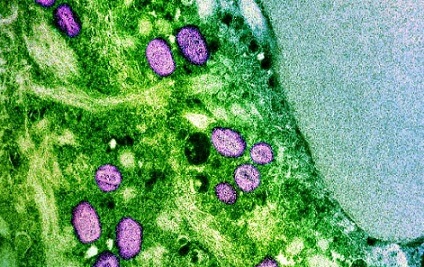Insights into Monkeypox (Mpox) virus defense mechanisms-Decoding the mRNA Cap N7 Methyltransferase complex
Sebastian Lavoie Fact checked by:Thailand Medical News Team Sep 04, 2024 1 year, 3 months, 4 weeks, 5 hours, 54 minutes ago
Medical News: The global outbreak of the monkeypox virus (MPXV), an orthopoxvirus responsible for causing zoonotic viral diseases, has become a significant public health concern. As scientists race to understand the virus better, a team of researchers from Fudan University, the Chinese Academy of Sciences, and the Naval Medical University, all based in Shanghai, People’s Republic of China, have provided crucial insights into the molecular mechanisms that MPXV uses to evade the host's immune system. This
Medical News report explores their findings and the implications for developing future antiviral treatments.
 Insights into Monkeypox (Mpox) virus defense mechanisms-Decoding the
Insights into Monkeypox (Mpox) virus defense mechanisms-Decoding the
mRNA Cap N7 Methyltransferase complex
The Molecular Defense of MPXV
MPXV has a complex structure that allows it to efficiently replicate within host cells while avoiding detection by the immune system. One of the critical elements in this process is the mRNA cap N7 methyltransferase (RNMT) enzyme, which methylates the N7 position of guanosine in the mRNA's 5’-cap structure. This modification is vital for the stability and translation of viral mRNA, making it a target of interest for researchers.
The study conducted by the team from Shanghai focuses on the interaction between the large subunit (E1) and the small subunit (E12) of the RNMT enzyme in MPXV. By examining the crystal structures of these proteins and their complexes, the researchers have uncovered how these components assemble and function, providing a foundation for future drug development aimed at disrupting this process.
Key Findings of the Study
-Structural Insights into the E1 and E12 Subunits
The researchers solved the crystal structures of the E12 subunit, the MTase domain of the E1 subunit in complex with E12 (E1CTD-E12), and the E1CTD-E12-SAM ternary complex. These structures revealed detailed conformations of critical residues and the structural changes that occur when E12 binds to E1.
The study showed that the interaction between E1CTD and E12 is primarily driven by hydrophobic interactions, with residues Lys31 and Arg49 on E12 forming salt bridges with Asp587 and Glu814 on E1CTD, respectively. This interaction is crucial for the stability and function of the RNMT complex, as mutations in these residues significantly decreased binding affinity.
-The Role of SAM Binding
S-adenosyl-L-methionine (SAM) plays a crucial role in the methylation process carried out by RNMT. The study found that the N-terminal extension of the E1 subunit (Asp545-Arg562) and the E12 subunit are essential for SAM binding. The researchers used isothermal titration calorimetry (ITC) to determine that the binding affinity of SAM to the E1CTD-E12 complex was significantly higher than to E1CTD alone, indicating that E12 binding induces conformational changes in E1 that facilitate SAM binding.
Comparison with Vaccinia Virus
trong>
The research team also compared the MPXV RNMT complex with its homolog in the vaccinia virus (VACV), which shares a high degree of structural similarity. They found that, like in VACV, the small subunit (E12 in MPXV, D12 in VACV) plays a crucial role in stimulating the methyltransferase activity of the large subunit. However, despite these similarities, the study also highlighted some significant differences, particularly in the amino acid residues involved in SAM binding and the overall structural dynamics.
Implications for Antiviral Drug Development
The detailed structural information provided by this study opens new avenues for developing antiviral drugs targeting the RNMT complex of MPXV. By understanding the precise interactions between the E1 and E12 subunits and how these interactions facilitate the methylation process, researchers can design inhibitors that disrupt these processes, potentially leading to effective treatments for monkeypox.
The study's findings suggest that targeting the interface between the E1 and E12 subunits or the SAM binding site could be particularly promising strategies. Additionally, the researchers' identification of key residues involved in these interactions provides specific targets for drug development.
Conclusion
The recent study by researchers from Shanghai has significantly advanced our understanding of the molecular mechanisms used by MPXV to evade the host immune system. By revealing the structural basis of the RNMT complex and its role in viral mRNA processing, the study provides valuable insights that could inform the development of new antiviral therapies.
As the monkeypox outbreak continues to pose a global health threat, research like this is crucial for developing effective countermeasures.
The study findings were published in the peer-reviewed journal: Emerging Microbes & Infections.
https://www.tandfonline.com/doi/full/10.1080/22221751.2024.2369193
For the latest Mpox News, keep on logging to Thailand Medical News.
Read Also:
https://www.thailandmedical.news/news/nuclear-signal-in-monkeypox-mpox-virus-protein-p2-is-key-to-immune-system-evasion
https://www.thailandmedical.news/news/italian-study-finds-that-the-immune-system-relies-more-heavily-on-cd4-t-cells-in-the-fight-against-mpox
